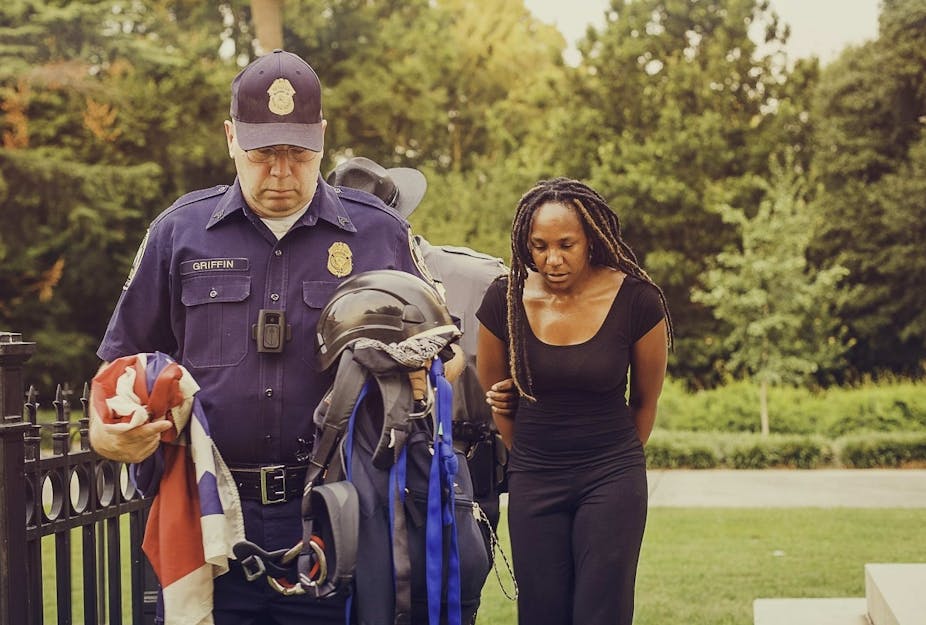On June 28, in the early hours of the morning, 30-year-old helmeted activist Bree Newsome scaled the flagpole at the South Carolina State House and cut down the controversial Confederate flag, which was first raised there in 1961, almost 100 years after the Civil War.
It’s easy to dismiss Newsome’s actions as a social media stunt. Many have ridiculed it as pointless (or worse, harmful) theatrics that might derail legal action to take down the flag permanently. For example, The Baltimore Sun quoted two South Carolina lawmakers – Democratic State Senator Marlon Kimpson and Republican State Senator Shane Massey – who called the action counterproductive:
Yes, Newsome was arrested and the flag went right back up.
But Newsome’s climb can be viewed as a significant piece of socially engaged performance art that brought attention to the flag issue. And in the long run, it will work to get it removed, while encouraging people to think about what the flag means, particularly to African Americans.
Two types of socially engaged art
Let’s take a closer look at why this is the case.
Socially engaged art can be divided into two categories: symbolic practice and actual practice. (Newsome’s climb is the latter.)
The ideas of symbolic and actual practice are key concepts in artist and performer Pablo Helguera’s book Education for Socially Engaged Art. Helguera, who’s also the curator of public programming for New York City's Museum of Modern Art, sees symbolic practice as socially motivated representations of ideas or issues in an artwork.
An example of symbolic practice would be artist Sonya Clark’s timely pieces “Unraveled” and “Unraveling,” which went on display at New York’s Mixed Greens gallery just days before the Charleston murders occurred.
In the work, Clark presents two Confederate flags. With volunteers, Clark completely unraveled one during performances in the space, with the threads bundled into separate piles of red, white and blue. The other is partially unraveled.
As the website Mother Jones pointed out, Clark uses the flag unraveling “to evoke the slow, patient work of unraveling racism.” Her work encourages contemplation and calls attention to what the Confederate flag represents.
Actual practice projects, on the other hand, involve direct action that can have an impact outside of gallery walls. For example, Rick Lowe’s Project Row Houses preserved and revitalized an historic Houston neighborhood. Meanwhile, Tania Bruguera’s Immigrant Movement International provides public workshops, events, actions and partnerships with immigrant and social service organizations in Queens, New York.

These projects are large in scale, and are grounded in art and aesthetics. They provide actual social and community services in addition to gallery, performance and gathering spaces.
Public expression promotes change
In his book, Helguera highlights the importance of both types of practice. He also looks at Jürgen Habermas’s Theory of Communicative Action, which proposes that social change can happen after individuals engage in public conversations that are rationally argumentative in nature. In other words, people need to “duke it out” publicly in civil disagreement.
Helguera notes that communicative action “can have a lasting effect on the spheres of politics and culture as a true emancipatory force.” It’s more than just talk.
Activist artists like Favianna Rodriguez, whose work is grounded in empowering people around issues of inequality and racism, point out that artists and other cultural workers are essential to creating significant and lasting social change. They do this by changing hearts and minds through culture, and by eventually shifting power in communities. Rodriguez sees legislative and policy change as a two-step process, and insists that “before you change politics, you have to change culture.”
In the case of the Charleston shooting, connecting the Confederate flag’s symbolism with the killer of nine black people at Bible study in their church provides an opportunity for this kind of national conversation.
So here’s why Newsome’s climb was a work of performance art: even though it happened in real life and in real time, it acted as a metaphor for the dismantling of institutionalized racism. Her Superwoman-styled action added a collective exclamation point to the demands to remove the Confederate flag, while tapping into the deeply rooted American mythology of individual heroism.
Individuals can galvanize large groups of people, leading to permanent change – that part of the myth is true. Newsome’s actions spoke to people who are tired of waiting for racial justice, and reenergized them for the rest of the battle.
Though her act of cutting down the divisive flag from the South Carolina State Capitol failed to permanently remove it, it drew waves of continued media attention to the issue. She performed an action movie gesture as a vicarious and thrilling experience for anyone who wanted this symbol of the Confederacy – synonymous with racism for so many people – removed, even for a brief time.

